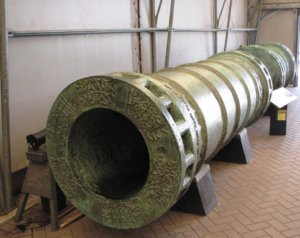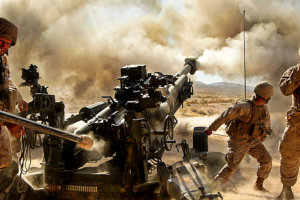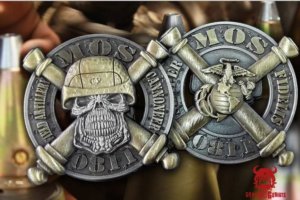USMC Artillery History
The first time long-range weapons appeared in war they were a success. Ancient artillery suppressed the enemy and allowed maneuver on the battlefield. Artillery originated from slings and javelins. However, as civilizations advanced their weapons of long-range war did too. Some primitive forms were slings, javelins, onagers, trebuchets, catapults, cross-bows, long-bows, and cannon.
Artillery, in the form of cannons, would have never existed without trade routes to China. This is because the Chinese had developed gunpowder long before the west. Gunpowder was an explosive mixture of sulfur, charcoal and saltpeter. When it was introduced to the West it had very explosive results (no pun intended).

Dardanelles Bombard
The Western world changed when the remnants of the Roman Empire fell in 1453 AD. During the siege of Constantinople. An urban metropolis and trading hub to the Mediterranean.
Constantinople was the most heavily defended city in the world. The Theodosian Walls were the largest anywhere. Yet one weapon would make short work of the wall. Constantinople fell to Sultan Mehemed II, of the Ottoman Empire in just 53 days! This was made possible by the Dardanelles Bombard, a 37,000 lb, 41.5 in diameter, muzzle-loaded, slow-match artillery behemoth.

Theodosian Walls of Constantinople
After such a powerful city fell and ended the 1,500 year Roman reign, it was not taken lightly. This powerful weapon ended the days of citadels and castle fortresses. It ushered in a new era of warfare that came to dominate the world. One fueled by gunpowder and explosives. Napoleon Bonaparte, a former artillery commander, would say that, “God fights on the side with the most artillery.”
World Wars
This saying did not become more true than after the outbreak of World War I. Both the Germans and French had fought themselves into a stalemate. Marked by stationary, fortified, entrenched lines that were almost impregnable. As the size of the fortifications grew, so did the artillery used to destroy them. WWI saw a rise of some of the most grotesquely large artillery pieces used in the war.

German “Schwerer Gustav” 800mm Cannon
During World War II this was not the case. Air power was now a viable asset in war. The ability for the enemy to “reach out and touch you” increased. Artillery then became lighter and more mobile. In the Pacific theater Marines had to amphibiously assault each island as they inched closer to Japan. Marine Artilleryman used 75mm Pack Howitzers and the M3 75mm Gun Carriage were just the right tool for the job.
Artillery in Warfare
In Vietnam the USMC used artillery in a very different role. As a part of an overall strategy the Marine Corps placed artillery units in “Fire Bases” across the AO (Area of Operations). Their range covered a 360 degree area that overlapped other units in supporting fire. This, coupled with airpower, was very effective in the war with the North Vietnamese.

M777 Firing 155mm Projectile
The role that USMC Artillery takes presently has changed over the course of American history. In 2003 during the initial phases of Operation Iraqi Freedom the artillery mission was clear “It absolutely had to be destroyed overnight.” This happened during the siege of Baghdad. As a result an ENTIRE Artillery Regiment got on line to fire volley after volley into the city.
Artillerymen began to take on a very flexible role in Iraq and Afghanistan. Their mission ranged from convoy security, provisional infantry, and military police. Marines are all Rifleman first. Mission flexibility comes with greater ease to Marines than any other service branch. In addition being a Rifleman effects a Marine’s mentality regardless of their MOS.
During the war in Iraq and Afghanistan the Marine Corps a “land-locked” force. With the addition of heavy “Armadillos” (up-armored 7-tons), the MATVs (Military All-Terrain Vehicle), MRAPs (Mine Resistant Ambush Protected), and even the MTVs (Modular Tactical Vest, which replaced Interceptors).

Artillerymen from India Battery prepare for foot patrol in Kajaki, Afghanistan 2010
Presently Artillerymen prove their domination on the battlefield. During Operation Inherent Resolve Artillerymen of the 26th MEU went back to Iraq to “hand-it” to ISIS. They fired over 3,000 rounds at ISIS targets. Proving again their versatility on the field of battle.
Expeditionary Role
Our Corps is an expeditionary force in readiness. Able to strike anywhere across the globe in 24-hrs. The upper echelon of command currently works to change our weaponry to suit the Marine Corps mission. The Marine Corps created the MV-22 Osprey, a rotor-wing/propeller design allowing vertical take-off and landing. The USMC Artillery at the time was the M198, which weighed a total of 16,000 lbs. However, it can not be carried by the Osprey. The Marine Corps teamed with BAE Systems to create the M777 Howitzer. Weighing a total of 9,277lbs, the M777 was originally created to be airlifted by the Osprey. In addition increasing or expeditionary capabilities.
The USMC Artillery community had the M198. After the introduction M777 Howitzer, HIMARS (High Mobility Artillery Rocket System), and the 120mm EFSS (Expeditionary Fire Support System) the M198 was phased out. A new “versatile” community would emerge. The EFSS Mortars have a decreased range, yet a higher trajectory. With the HIMAR Rocket System you have a complete advantage in range. However rockets are expensive and take longer load. The M777 falls between these two.
Artillery Mission Capability
The 155mm M777 Howitzer has a variety of ammo compared to its counterparts. In addition, this Howitzer is able to perform smoke missions, illum missions, lay anti-personnel mines, anti-tank mines, rain 88 grenades over a target, bunker bust, and traditional HE. Furthermore, the M777 is the current “staple” of Marine Corps Artillery.
Whatever the mission Artillerymen are flexible to the task. Ready to pull lanyards of anger, kick doors down, or slap a .50 on and guard a convoy 08’s are dedicated to mission accomplishment! This is why Devil Dog Shirts is paying homage to all the 08’s with our new designs. As an 0811 myself it is very important to give back to our community. In addition, perpetuating love and respect for our Corps!




To be honest an 0811 is probably the best Mos in the marines, cus you do grunt stuff amd you do it well, but in the rear, you don’t get treated like a grunt, you go to the gunpark, pt. But we would have a lot of downtime and get three hour lunch breaks, we pick up corporal with a low cutting score, so grunts will always have a harder time. So for me now that I am out and had a combat deployment, and having fired mortars and machinegun and carried a saw for my personal, that nothing is more devestating than accurate marine corps artillery fires when you are supporting the guys from your own battery. Knowing it was my platoon on patrol and my fellow marines, we would be highly motivated to deliver accurate fires and the pride marines take in everything else, artillerymen take in delivering pain when and where It is needed. It’s an artform.
So it was the golden calf that led Israel out of slavery after all?
chanel j12 homme [url=http://www.montrefr.com/]chanel j12 homme[/url]
Pull string, go boom.
You’ve got a new supporter and fellow 0811. “S” 5/11 1mardiv 2001-2005, (also “I” 3/11 for a deployment) before they went himars. Got to agree with all said already, kicked a$$ throwing rounds downrange in iraq. Except when we patrolled and found unexploded DPICM spheres in our way….
I only got to shoot DPICM once in my Marine Corps career. It was in 29 Palms.
Also, I served with a lot of motivators in Sierra Battery. It was either Sierra or Tango that ended up pulling a wrong grid and wiping out that entire family of Afghans around Marjah. When I first got to Leatherneck, the entire firing Battery was quarantined to the Gun-Park there while an investigation was under way. A few people I served with were there unfortunately. My Battery ended up RIPing with the 40th Royal Marines in Kajaki Sufla, during 2010, in Afghan. “I” 3/12 which was a part of of 1/11.
We appreciate your interest in Devil Dog Shirts! Take care Warfighter!
Semper Fi!
Sgt Wyble USMC (Ret)
hq@devildogshirts.com